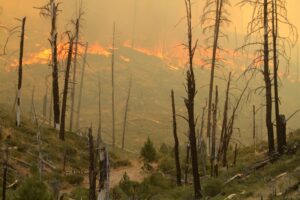Part of the ~111,000-acre Falls Fire on the Malheur National Forest in eastern Oregon is burning in the 2007 Bear Canyon Fire scar. I’m posting this photo by Mike McMillan/USFS only to show what a 17-year-old fire scar looks like, and that the dead down/standing and live fuels (saplings and brush) can burn with fairly high intensity. Click on the photo for a larger view. More at InciWeb.

So the new fire is burning in an area that burned 17 years ago. Am I incorrect in concluding that the 07 fire essentially did the same thing that a “vegetation treatment” would have?
Im assuming there was a surge in new vegetation after the fire in 07, and that is the fuel that is now most contributing to the current blaze.
Looks to me like this was certainly not the same thing that a “vegetation treatment” — it was a stand-replacing wildfire. Was it replanted? I don’t know. Anyone here know about the management (or not) after the 2007 Bear Canyon Fire?
Two days ago the FS fire team expected the Falls Fire would burn into the Bear Canyon fire scar where it would slow down, as reported in their daily sit report . . .
We must all understand that these fire scar “treatments” last no more than 2, maybe 5 years at most, depending upon how quickly the grass & brush species respond plus how many dead snags are left to decay either standing or on the ground after the previous fire.
In some areas, if grass fills in, much more than five years.. and decay comes slowly to drier areas..
Hi jg:
These reburns have been predictable for decades. The “Six-Year Jinx” of Tillamook Fires followed the 1918 Cedar Mountain Fire and some 1920s reburns to burn catastrophically in 1933, 1939, 1945, and 1951 until corrective actions put a stop to this history.
On the other hand, in a slightly different climate to the south, the Kalmiopsis Wilderness has also reburned several times, beginning with the Silver Complex in 1987, Biscuit Fire in 2002, Chetco Bar Fire in 2017, and the Klondike Fire in 2018.
These “let it burn” and “managed wildfire” strategies are a proven failure and a strong indication of incompetence by their advocates and perpetrators. This nonsense should have been stopped before it was ever allowed to take place. Opinion, based on common sense, science, and serious concern.
Hi Steve,
Looks like this human-caused fire has burned during a time period where high temps were between 95 and 105. What were the winds doing? How much logging and livestock grazing has taken place in this area? How many flammable noxious weeds? How much the current wildfire was intentionally burned after the fire started?
The Inciweb says this today: “Fuels are at low fuel moisture values, with 1000 hour fuels at or below 10%, and 100 hour fuels below 7%. FDFM is between 2 and 5 (shaded) percent. Live fuels are moving down below 100%, so are available for combustion.”
Is that extreme? Is the fire in your photo (assuming it wasn’t an intentionally lit backburn) really uncommon given these conditions? I’m also not sure that’s a high intensity fire. Seems pretty tame, all things above considered.
The Fall Fire is burning through a number of our restoration treatments, so it will be interesting to see how they fare.
The weather here has been very hot and very dry, and afternoon winds have been fierce and shifty, pushing the fire around a fair amount.
We also had a bunch of dry lightening last night, so we’ll see whether that manifests in new runs (there was already a small start that the Forest Service caught NW of the Fall Fire).